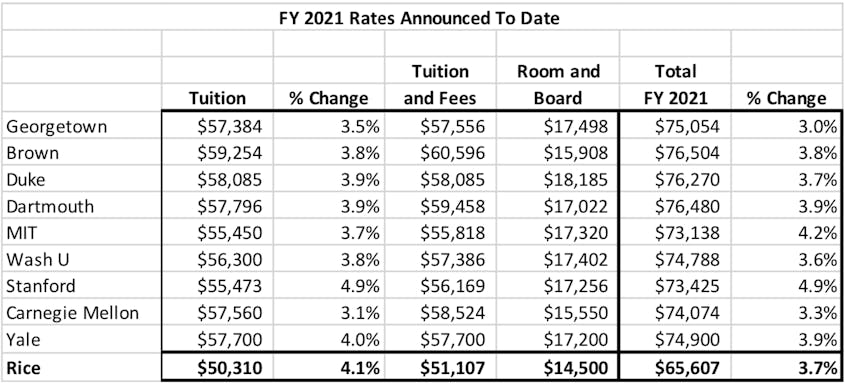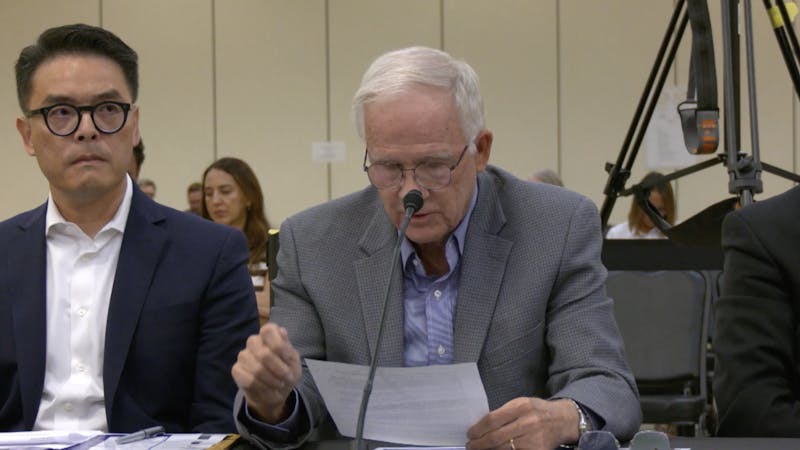‘Tuition increases every year’: VP for Finance Kathy Collins explains Rice’s costs

Infographic by Mateo D'Agaro
Last week, Rice announced that undergraduate tuition for the 2020-21 school year will rise by 4.1 percent to $50,310, an increase of $1,980 over the current year’s tuition, following annual trends of the past 10 years. The Thresher reached out to Vice President for Finance Kathy Collins to learn more about the undergraduate costs of attendance.
Next year’s total cost of attendance, which will include $14,500 for room and board and $797 in mandatory fees, will increase by 3.7 percent to $65,607.
Using data from Rice University’s Common Data Set, the Thresher has created the following interactive charts and tables to show the annual trends for tuition, room and board and mandatory fees over the last 10 years. Data from the U.S. Bureau of Labor Statistics’s consumer price index inflation calculator was used to estimate what all the costs would be in 2020. Read on to hear what Collins has to say about these trends, as well as the implications of the pandemic on financial aid:
Rice Thresher: Were there any unique factors that drove this year's tuition increase?
Kathy Collins: There were no unique factors driving this year’s decisions on tuition. Keep in mind that the operating cost for one year of an undergraduate education (not counting room and board) is about $100,000. At a tuition rate of $50,310, a student paying full-price pays about 50 percent of that cost. The university covers the rest from the endowment and other revenue sources.
Note: Collins said that the $100,000 cost of one year of undergraduate education is only an estimate. According to Collins, the $100,000 estimate was calculated based on expenses reported in financial year 2019 statements, excluding costs that are “explicitly graduate student-related” and all research grant expenses. Collins said that costs associated with housing, dining and parking were also excluded as they are billed directly to undergraduates, but capital improvements made to the campus facilities were included in the costs. The remaining expense amount was proportionally split between undergraduate and graduate populations and the per-student cost was derived by dividing the undergraduate portion by the number of degree-seeking undergraduates.
RT: How was the specific tuition increase decided?
KC: The Board of Trustees provides guidance on the range of tuition increase and the administration makes the final decision. We do keep in mind the tuition rates charged by our peers. Rice has always had the lowest tuition price of the Association of American Universities private universities, on average about $6,000 below. That gap has widened a bit in recent years to about $7,000.
Note: The Thresher checked the 2020-21 tuition rates for all 26 AAU private universities. Six schools had not yet released 2020-21 tuition rates at the time of publication, so their 2019-20 rates were used as a substitute. The calculated average tuition difference of $5,709 is likely lower than the actual value for 2020-21 due to our use of 2019-20 tuition rates for some schools. Based on this data, Collins’s claim about Rice’s tuition being lower by an average of $6,000-$7,000 appears to be true. The Thresher could not confirm that Rice has “always” had the lowest tuition among AAU privates due to unavailability of historical data.
RT: Will the financial aid budget be expanded to account for the tuition increase?
KC: Rice has always increased financial aid along with any price rise. We raise the financial aid budget by at least the [increase in] cost of attendance, which includes tuition, room and board, mandatory fees and an allowance for living expenses, books and transportation. For entering students, we include the cost of [Orientation] Week and for entering international students, we [also] include the cost of [the International - Preparation and Regulatory Education Program].
RT: How has the financial aid budget changed in recent years? How will it change for next year?
KC: Spending on financial aid has increased significantly. In the last five years, financial aid has increased 47 percent from $68 million (in FY 2015) to an estimated $101 million this year (FY 2020), representing an average annual increase of 8.2 percent. We expect to increase financial aid for FY 2021 by at least the increase in the cost of attendance but we are still working on this. Because we meet the full need of our students as determined under The Rice Investment by the financial aid office, it is not possible to say what the exact increase in aid will be until we know which admitted students will be attending.
RT: Will aid to international students be expanded since they don't qualify for the Rice Investment?
KC: Even though international students are not eligible for The Rice Investment, Rice does meet [the] full need for those international students who are admitted and enrolled. So the amount of aid depends on the financial need of the international students who are enrolled in 2020-21. Rice has been increasing financial aid for international students. In FY 2015, the amount was $2.1 million. The estimated amount for this year, FY 2020, is $4.6 million.
Note: Rice is not “need-blind” for international student admissions like it is for domestic students. According to the Office of Financial Aid, the amount of financial aid that an international student’s family “might need” is used in admissions decisions.
RT: How does the COVID-19 pandemic impact the university’s finances?
KC: The tuition rate was decided before the recent turmoil in financial markets. The decline in the endowment as a result of the financial fallout from the pandemic is likely to be substantial. We are analyzing the impact of the financial situation on our budget plans, but no budget reductions will be applied to financial aid since it is based on need.
RT: How does the COVID-19 pandemic impact financial aid for Rice families?
KC: As President [David] Leebron made clear in the tuition announcement, we realize these are uncertain times and that there will most likely be an impact on financial aid to respond to family circumstances. At the same time, we want to make our best effort to protect the jobs of Rice staff. While net undergraduate tuition only provides a small portion of total revenues at Rice, every source of revenue is considered in our effort to provide the best education and fair treatment of faculty and staff while balancing the budget.
Note: According to Collins, undergraduate tuition and fees account for about 13.3 percent of the $787 million total operating revenues reported in Rice University’s FY 2019 financial statements.
RT: Why does the tuition increase every year? Is inflation the main factor for the tuition increase or is it increased operating costs?
KC: Tuition increases every year because the costs of running the university and providing the range and quality of programs and services increase each year. This is true across the higher education sector.
Note: The below table, which was provided by Collins, shows 2020-2021 tuition rises announced by peer institutions. The data was fact-checked by the Thresher.

KC (continued): Our main sources to support the operations of the university (other than housing and dining) are endowment distributions, research funding, tuition and annual giving. Operating costs do increase every year just to continue current programs. Among those growing costs are new faculty, new programs, increased student services, operation and maintenance of the campus, information technology and network security, library services, regulatory compliance, insurance and compensation. The capital improvements made to the campus facilities add operating costs and interest payments on debt.
Note: As shown in the interactive table below, the Thresher has re-calculated Rice’s cost of attendance percentage increases for the past 10 years, accounting for CPI-measured inflation.
According to Collins, inflation specific to higher education, measured by HEPI (higher education price index), has run slightly higher than the general CPI-measured inflation index for at least the past 10 years. However in a 2011 policy paper from the Center for College Affordability and Productivity, Andrew Gillen and Jonathan Robe argued that CPI was a more appropriate measure to use when adjusting tuition for inflation because “adjusting for inflation using the CPI puts the figure in a context that we can all understand because everything else is adjusted using the CPI as well.”
Interactive charts and tables were created by Assistant Web Editor Mateo D’Agaro.
More from The Rice Thresher

Rice announces Chao College as 12th residential college
Rice announced that the 12th residential college will be named Ting Tsung and Wei Fong Chao College Aug. 19. The college, set to open in fall 2026, will contain nearly 300 on-campus beds.
Dining access fund announced following on-campus unlimited meal swipes
Rice announced new food assistance programs on Tuesday to account for the controversial change in the on-campus meal swipe plan.

Rice disaster prediction model discussed at hearing on deadly Central Texas floods
The House and Senate Select Committees on Disaster Preparedness and Flooding held a hearing on July 31 in Kerrville to address the deadly July 4 flooding in Central Texas. The flooding along the banks of the Guadalupe River killed 108 people, including 37 children. In the charged hearing, Texas lawmakers and flood survivors criticized the local response to the disaster.


Please note All comments are eligible for publication by The Rice Thresher.